Geckos are easy to care for, docile and live well as pets.
This makes them a great choice for first time keepers.
Many species have beautiful color and pattern combinations and are very friendly.
When choosing a pet Gecko it is important to know some species are more beginner friendly. Some species are outgoing and friendly while others are shy and hide.
It is important that a beginner adopts the right species for them.
Continue reading to discover our top 15 pet gecko species for beginners.
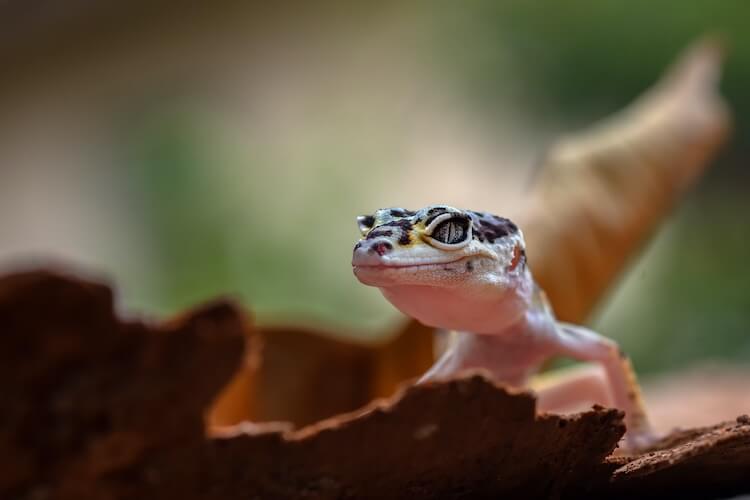
A-Z List of Pet Geckos
| Species | Appearance | Price | Rank |
|---|---|---|---|
| African Fat-Tailed | Similar to a Leopard Gecko with a characteristically fat tail. | $125 to $150 | 3 |
| Chinese Cave | Brown to purple-gray with black and yellow bands and spots. | $100 to $300 | 5 |
| Crested | Sunset-yellow body with a triangular shaped head and large round eyes. | $50 to $100 | 2 |
| Common House | Tan bodies and large lidless eyes. | $5 | 6 |
| Chahoua | Red, green and browns to help them blend in with their surroundings. | $850 to $2,000 | 7 |
| Flying | Brown, black and tan giving them a mossy appearance. | $25 to $40 | 11 |
| Frog-Eyed | Yellow-tan and white in color with mottled spots of brown. | $50 to $80 | 15 |
| Giant Day | One of the biggest species of Day Gecko and bright green. | $50 to $250 | 10 |
| Gargoyle | Leaf-like appearance with snake-slit eyes. | $225 to $500 | 4 |
| Gold Dust Day | A base color of green with red and blue patterning and small yellow spots. | $50 to $250 | 9 |
| Leachie | Large species that can grow to over one foot long. | $600 to $1,000 | 12 |
| Leopard | Shades of yellow to tan with white bellies and dark brown spots. | $20 to $50 | 1 |
| Madagascar Ground | Auburn eyes, brick-red body and brown tan and white mottling. | $25 to $100 | 14 |
| Mediterranean House | Purple to tan with dark spots and large round eyes. | $30 | 8 |
| Yellow-Headed Day | Four inches long and vivid bright neon stripes. | $150 | 13 |
Top 15 Geckos For Beginners
15. Frog-Eyed Gecko
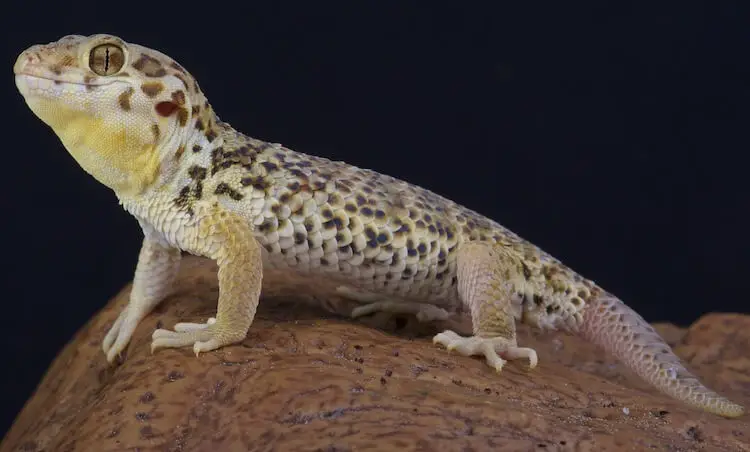
The Frog-Eyed Gecko is named after their large slit-like eyes.
At first glance Frog-Eyes look very similar to the more commonly known Leopard Gecko (#1). But, they are actually a bit stockier and do not have vivid patterns.
They are often yellow-tan and white in color. They have mottled spots of brown and tan covering their backside and the top of their head.
Frog-Eyed Geckos are from central Asia and live in a hot and dry environment. A beginner will need to keep their enclosure between 84 to 93ºF to keep them healthy and happy.
This species is best kept by a patient beginner or advanced keeper. They are not as low maintenance or outgoing as many other species.
After adopting this pet you will soon learn that this species loves running to the edge of their enclosure and watching the outside world. Owners love this about their personalities.
Frog-Eyed species are great for anyone who wants to watch a Gecko, but not handle them. Handling stresses this species and may cause them to lose their tail.
A dedicated beginner can care for this reptile provided their temperature and humidity are taken care of.
- Personality: Naturally curious and likes to watch from afar.
- Size: 5 to 8 inches.
- Lifespan: 20 years.
14. Madagascar Ground Gecko
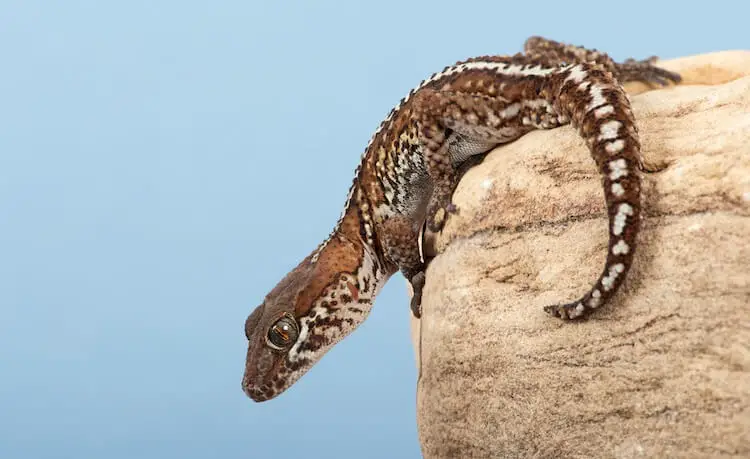
Owners love the Madagascar Ground Gecko their unique color patterns.
They often have auburn eyes that match well with their brick-red body and brown, tan and white mottling.
The Madagascar Ground Gecko has many names including:
- Ocelot
- Panther
- Ground
There are actually 22 different subspecies of Madagascar Ground Gecko. But, the best pet species is the Paroedura pictus.
Madagascar species make a great choice for beginners.
Unlike most Geckos they are terrestrial so they do not need a tall tank to climb in. They are also small and measure five inches as adults. This means they do not need a lot of space and can thrive in a 10-gallon tank.
This species also tolerates infrequent handling.
They are a good choice for owners who want to occasionally handle their pet.
- Personality: docile and tolerate handling.
- Size: 5.5 inches.
- Lifespan: 6 to 10 years.
13. Yellow-Headed Day Gecko
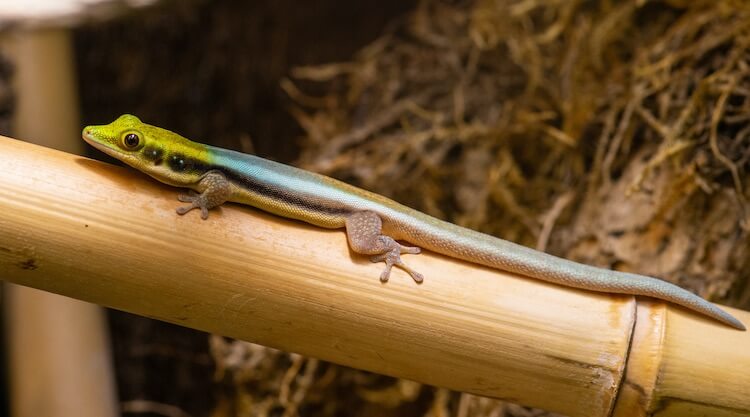
The Yellow-Headed Day Gecko is a member of the Day Gecko family.
Day species make great pets because they are easy to care for and brightly colored.
They make a great choice for a beginner who wants to care for a vividly colored Gecko.
Yellow-Headed species are different from many Day Geckos because of their slim size, bright neon stripes and social behavior with other lizards. Because of their social behavior it is possible to house multiple females.
Adults grow to just four inches. But, despite this they need a large tank to show the full range of their energy and personality.
Like the Madagascar Ground Gecko (#12) this species is also from Madagascar. If you travel to Madagascar it is not uncommon to see them resting on bamboo!
Yellow-Heads are protected in their natural habitat so you can only buy captive bred species.
They are best suited for a gentle beginner who is a fan of bright colors and social lizards. This reptile can be shy around people but it can be fun to house a family.
- Personality: Less territorial than other Day subspecies.
- Size: 4 inches.
- Lifespan: 10 years.
12. Leachie Gecko
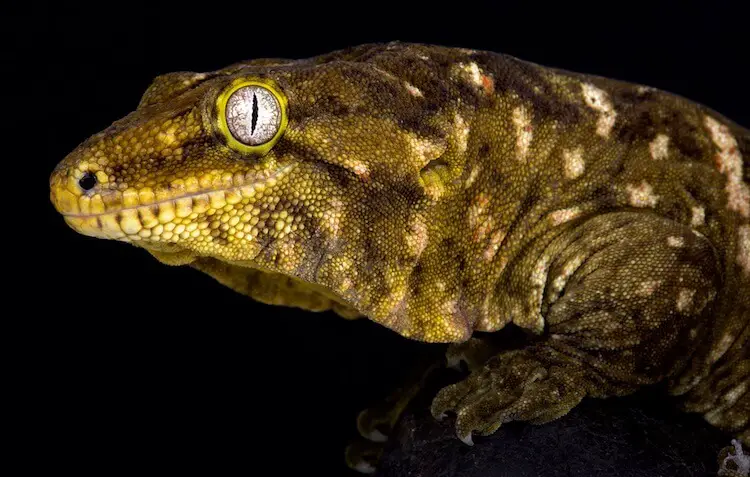
The Leachianus is also known as the New Caledonian Giant Gecko.
Leachies are one of the largest pet geckos.
Adults can be over one foot long and make a very unique pet because of their size. Most types of geckos stay under six inches.
Leachies are especially known for their unique vocalizations. They bark, yip and grow throughout the night as they are nocturnal.
A dedicated beginner who does their research and provides routine husbandry can care for this species. But, they historically do best in experienced homes.
This species can be a lot of work due to their size and personality. They are large and need lots of space.
They are also more expensive than most pet Geckos and can be very territorial.
- Personality: Cautious, territorial and vocal.
- Size: 8 to 17 inches.
- Lifespan: 20 years.
11. Flying Gecko
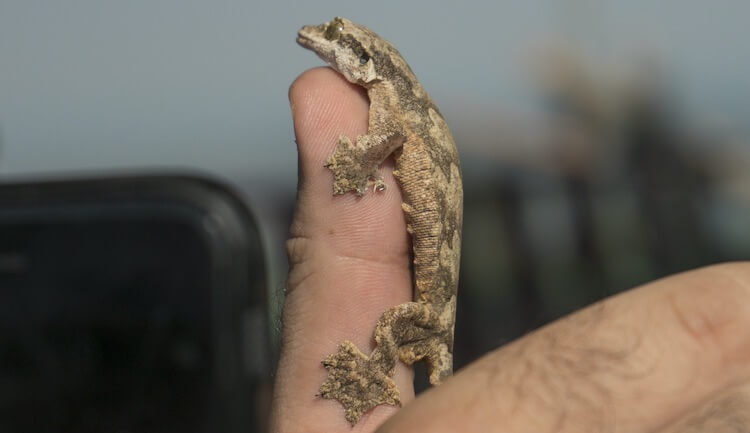
The Flying Gecko is found high in the trees of Indonesia.
This pet Gecko has a mossy appearance with colors of brown, black and tan. Their appearance helps them blend in with the environment.
Amazingly this species has webbed toes and a flat tail that they use to “fly”. This Gecko can leap from tree to tree by pulling in their feet and flapping their tail.
Flying species usually do not display their flying behavior in captivity due to a lack of space.
Beginners should try using a 50-gallon tank for this pet and decorate the tank with dense branches and plants.
Flying species are very easy to care for in captivity but have a temperamental personality. They are quick, hard to catch and do not enjoy handling. They need an owner that is gentle and patient, and so are suited to adult beginners.
- Personality: Nocturnal, skittish and timid.
- Size: 6 to 8 inches.
- Lifespan: 5 to 8 years.
10. Giant Day Gecko
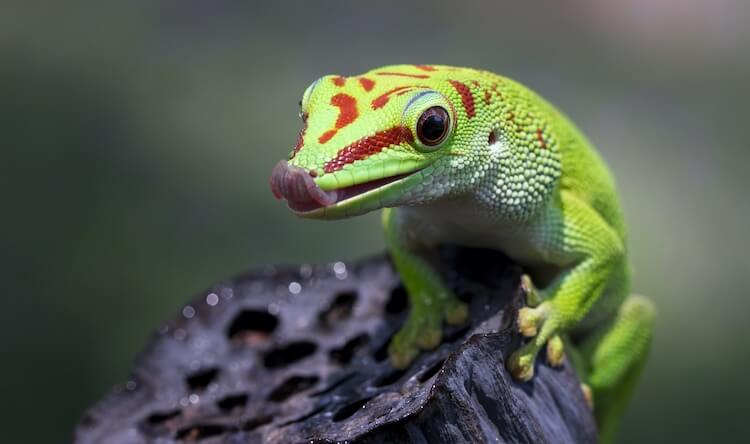
The Giant Day Gecko is another species from Madagascar.
This species is normally found high up in the trees of Madagascar. They like to spend their time soaking up the sun clinging to tree trunks and branches.
They are one of the biggest species from the Day family and are a bright green. Some species have bright blue and red patterns too.
Their color can change slightly to show stress levels or to communicate with other species. Like many species of Gecko, they do not like handling and may lose their tails if they become too stressed.
Beginners should know that Giant Days are great at escaping from their tank.
They should make sure they have a good setup and a tight lid.
Giant Day species are perfect for beginners who want a brightly colored lizard to quietly look at during daylight hours.
- Personality: Territorial with other lizards.
- Size: 12 inches.
- Lifespan: 6 to 8 years.
9. Gold Dust Day Gecko
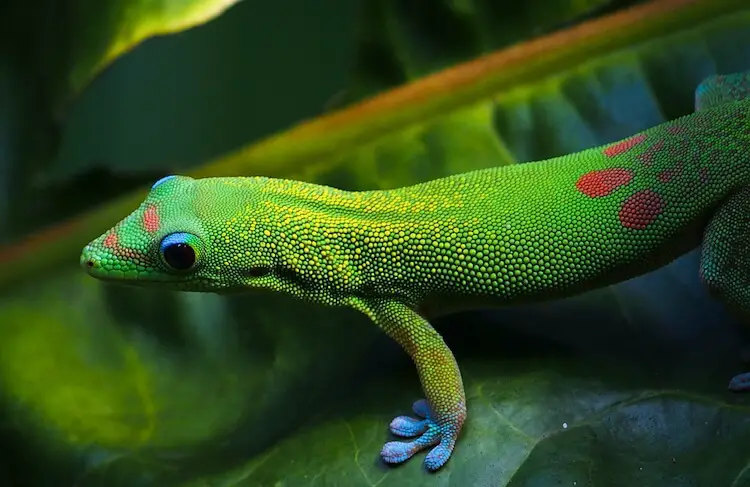
Gold Dust Day Geckos are a green colored species from Madagascar.
This reptile has a base color of green with red and blue patterning. They are also flecked with small yellow spots that give them their Gold Dust name.
The Gold Dust Day is the last of three Day Gecko species on our list.
Similar to the Neon Day (#13) this lizard is smaller than most species. They also have more color variety than their Giant Cousin (#10).
Like all Day species they do not enjoy handling.
Gold Dust species are naturally shy and enjoy hiding in plants or behind rocks.
While they cannot be handled, their ease of care and mild temperament make them good pet Gecko.
- Personality: Curious but easily stressed by handling.
- Size: 6 to 9 inches.
- Lifespan: 10 years.
8. Mediterranean House Gecko
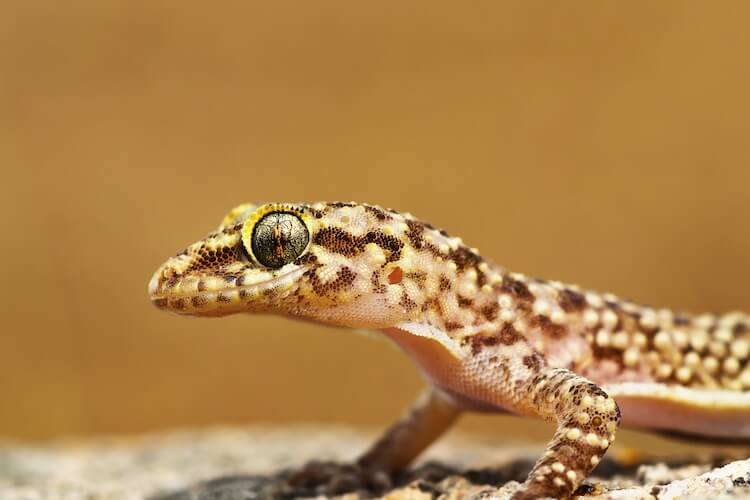
Mediterranean House Geckos are native to southern Europe and northern Africa. They are usually purple to tan with dark spots and large round eyes.
This lizard is not very big and lives very happily in a tall 20-gallon tank.
Mediterranean House species are normally found near or living inside houses or offices.
In the last two decades this Gecko has also been introduced to parts of Texas because of cargo ships that travel between Europe and America.
What makes this lizard such a great beginner Gecko is that it may already want to live in your house.
They are hardy and very comfortable living with humans.
For beginners in Europe and Northern Africa they make a great first-time pet.
- Personality: Happy around people and not as shy as Day Geckos.
- Size: 4 to 5 inches.
- Lifespan: 5 to 10 years.
7. Chahoua Gecko
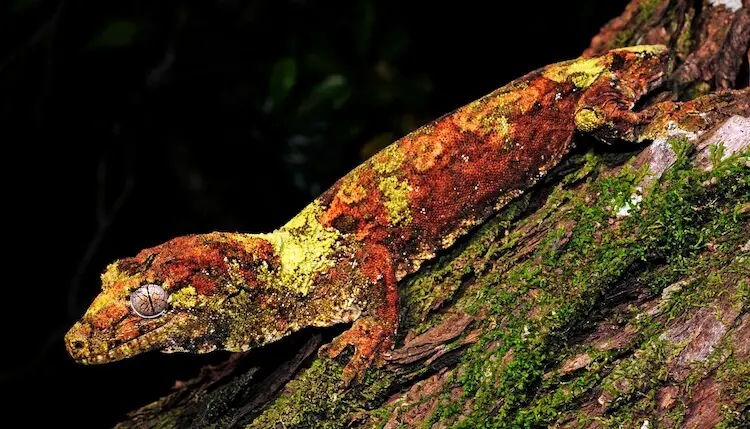
The Chahoua is another New Caledonian species (#12) that is found in the treetops of rainforests.
They are called Chahoua because of their scientific name Rhacodactylus chahoua. They are also known as:
- New Caledonian Mossy Prehensile-Tailed.
- “Chewie”
Chahoua Geckos are low maintenance. They are nocturnal, so they do not require any additional lighting. They also have a healthy appetite and will eat commercial Crested Gecko food.
This pet lizard is very friendly and enjoys being handled occasionally. Though, if they are not handled as juveniles, they can be jumpy.
Their only downside is how expensive they are, as juveniles they can cost $2,000.
- Personality: Very friendly and likes to see what is going on outside of the tank.
- Size: 10 inches.
- Lifespan: 20 years.
6. Common House Gecko
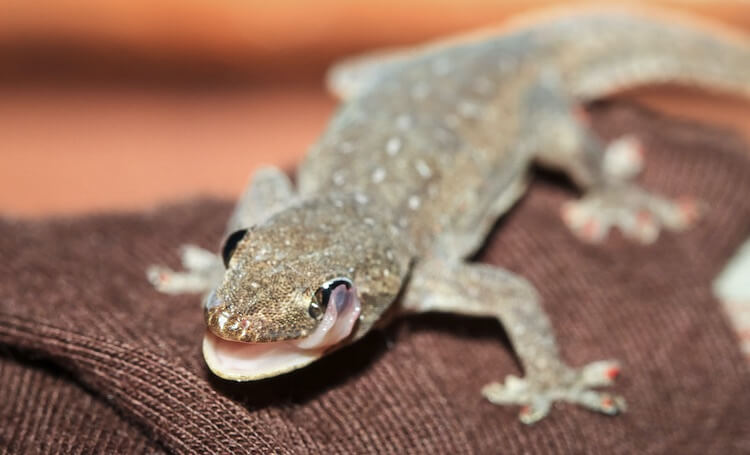
The Common House is known as an Asian House Gecko.
This pet reptile is very similar in appearance to the Mediterranean House Gecko (#8). They both have tan bodies and large lidless eyes. They have also been introduced to other parts of the world through human travel (like the Mediterranean House Gecko in Texas).
Unlike the Mediterranean species, this reptile is from southeast Asia and not Europe.
In the United States Common House Geckos are commonly found in Texas and Florida.
They are nocturnal and are often found near artificial light sources at night. They eat the insects that are drawn to this light.
This species adjusts very well to being kept as a pet because they are already found in homes. But, they are quick and do not like handling.
Instead they are happier spending time in your presence.
They make great pets due to their adaptability and suit beginners who want a low maintenance Gecko.
- Personality: Enjoys sharing space with humans.
- Size: 3 to 6 inches.
- Lifespan: 5 years.
5. Chinese Cave Gecko
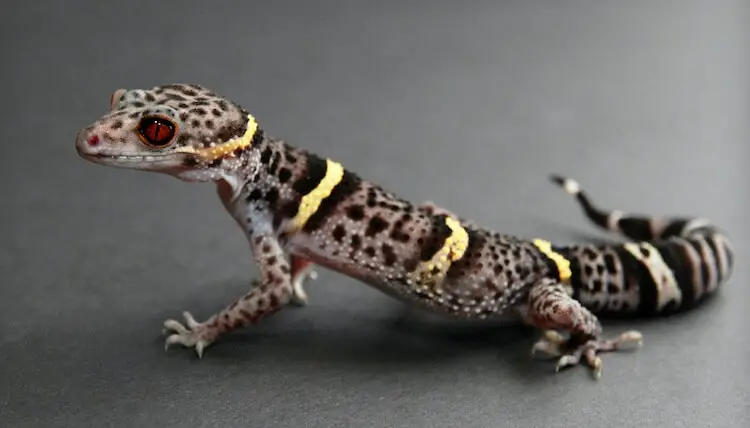
Chinese Caves are a hardy Gecko that are great for a beginner.
This type of Gecko is from the same genus as the Leopard (#1) and African Fat-Tailed (#3) species. Chinese Caves are not as common as their Leopard Gecko cousins, but they are just as easy to care for.
These lizard are usually brown to purple in color with black and yellow bands and spots.
There is little on the negative side of caring for this pet.
Chinese Caves do not need special lighting (because they are nocturnal), thrive at room temperature (unlike most reptiles that need 80ºF+) and can live in a 10 gallon tank. They also tolerate handling.
They are hardy pets and great for anyone learning to care for a Gecko.
- Personality: Docile, shy and not territorial.
- Size: 8 to 9 inches.
- Lifespan: 15 years.
4. Gargoyle Gecko
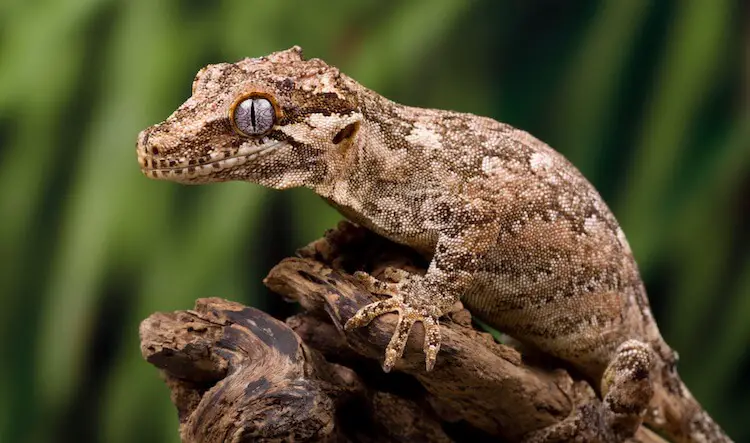
Gargoyle Geckos are a great pet for beginners.
They are easy to care for, easy to feed and enjoy handling. Compared to most species on this list they quite enjoy frequent human interaction and occasional handling.
What is most unique about this species is their leaf-like appearance. Their snake-like eyes compliment their mottled brown skin that makes them perfect for camouflaging in the forest.
The Gargoyle Gecko is a semi-arboreal species that can be found up in the trees or on the ground.
Like many nocturnal species they do not require any special lighting. They are also healthy in temperatures of 70 to 80ºF.
Gargoyles are great for nearly all beginners. They have simple care requirements and tolerate handling.
- Personality: Enjoys human interaction and handling.
- Size: 7 to 9 inches.
- Lifespan: 20 years.
3. African Fat-Tailed Gecko
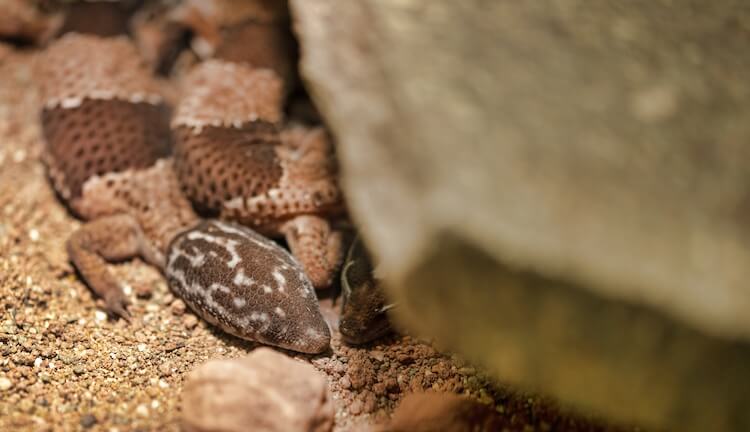
The African Fat-Tailed is a relative of the Chinese Cave (#5) that is named after their characteristically fat tail. They look very similar to Leopard Geckos (#1) but are smaller in size.
This lizard can be found in savannahs and the edges of rivers in West Africa.
African Fat-Tailed Geckos make a fantastic choice for many reasons.
1. It is common for them to be kept as pets so their care requirements are well documented.
2. They have fantastic temperaments and are slow-moving so beginners can easily handle them.
3. They do not need special lighting.
4. They are easy to house and feed.
The African Fat-Tail is suited to anyone looking for their first pet reptile. They are a fascinating reptile.
- Personality: Calm, docile and slow-moving.
- Size: 7 to 9 inches.
- Lifespan: 10 to 25 years.
2. Crested Gecko
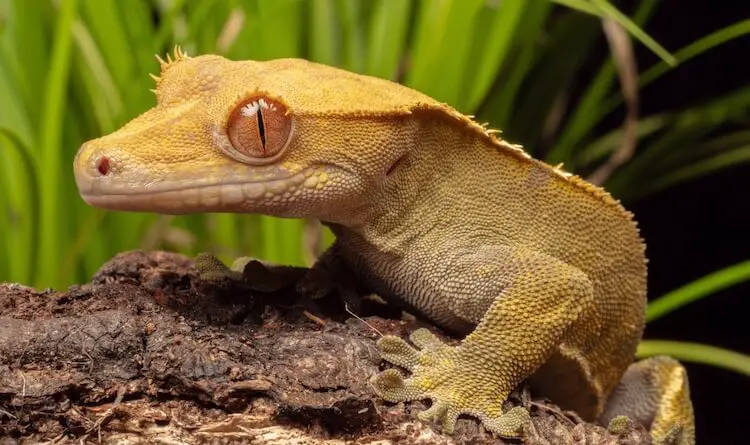
The Crested Gecko is the most popular pet Gecko from the Rhacodactylus genus. They are named after the crests that run from their eyes down the length of their backs. They are unique because of these eyelash-like crests that help to keep out dust and dirt.
Crested Geckos have triangular shaped heads and large round eyes. Interestingly, they lick their eyeballs to clean them (as do most species on this list).
This species has snake-like eyes that are usually a pale orange color. Their eyes compliment their sunset-yellow body color.
The Crested is a great pet for beginners because of their well-rounded characteristics.
They are solitary and nocturnal so do not require special lighting. They are also very easy to maintain and are docile. Because of their gentle nature, they can be handled nearly every day.
- Personality: Gentle disposition and can be handled.
- Size: 6 to 10 inches.
- Lifespan: 15 to 20 years.
1. Leopard Gecko
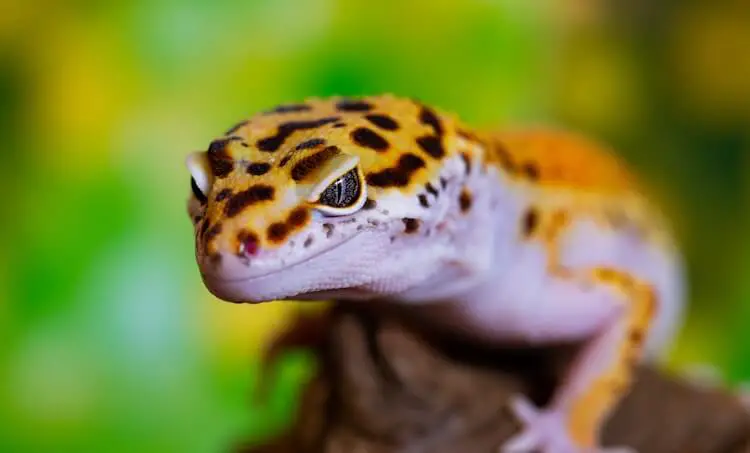
Leopards make the best pet Gecko!
They are not just a great first gecko but they are a great first reptile. They are docile and very tame pets.
Many first time keepers have successfully kept this species. Leopard species are easy to feed, do not need large tanks and are generally very healthy. They are also nocturnal so do not require special lighting.
There are also many keepers that have successfully bred this species in captivity.
The Leopard Gecko is from southwestern Asia and is named after its beautiful spots.
This species comes in many different morphs and colors. A wild type has a body with shades of yellow to tan. with white bellies and dark brown spots.
Leopards are unique and differ from many other pet geckos because they have moveable eyelids. This means they do not lick their eyeballs to clean them.
- Personality: Very docile and easy to tame.
- Size: 7 to 10 inches.
- Lifespan: 10 to 20 years.
Which Gecko Is The Best For You?
Geckos are interesting reptiles and make great pets.
Many species in this list are similar in appearance but are completely different in their care needs, personality, and habitat. It is important that any keeper understands which type of Gecko is best for them.
Here are some things to consider.
Some are cheaper than others.
Leopard, Crested, House, Flying and Frog-Eyed Geckos are the cheapest beginner friendly species. Gargoyles, Chahouas, Leaf-Tailed and Leachies are very expensive.
Many geckos on this list are easy to care for, but some species become too stressed with handling. If you would like to handle your lizard then consider getting a Leopard, Crested, African Fat-Tailed, Gargoyle or a Mediterranean Ground. Beginners are normally more comfortable handling smaller species such as the Mediterranean and Leopard.
Some species have simple husbandry needs and are hardy. Some are not.
Common House Geckos often have short lifespans, but Leopard, Frog-Eyed, Gargoyle, African Fat-Tail and Crested Geckos can live for 20 years.
It is important to know that all of the species above are suited to different owners.
Which one is your favorite?
Let us know in the comments below!

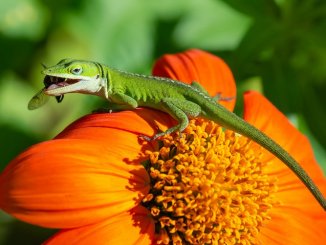
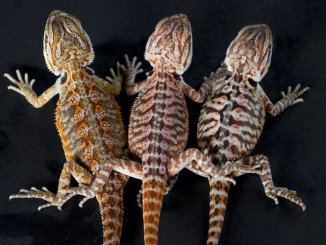
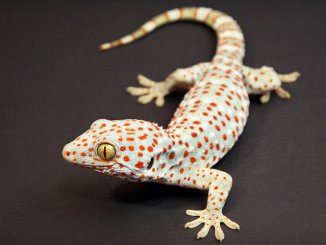

I believe that Crested Geckos are the best beginner lizard and reptile because they do not require heating if your house stays at room temperature year round, although mine, Blue, does have a heat mat just to be safe, they do not need UVB lighting, and they do not require a ton of food. They can be fed a Crested Gecko diet every other day as juveniles, which is very easy to acquire and not nearly as gross as insects to feed. However, I still do have to feed Blue crickets about once or twice a month, just to maintain great health, and they do need a tall cage and high humidity, as well as being higher up in price, although if more people kept them, maybe the price would go down…